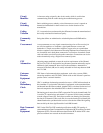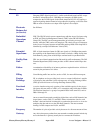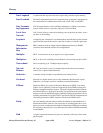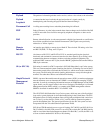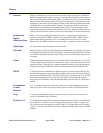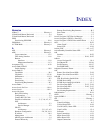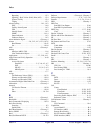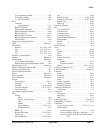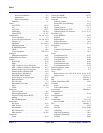
Access Navigator - Release 1.8 August 2003 GlossaryGlossary-11
Glossary
Payload The portion of a framed signal that carries services, such as voice or data, to the subscriber.
Payload
Loopback
A connection that loops back only the payload portion of a signal, usually by
demultiplexing and extracting the payload data and then reframing it.
Permanent Call A calling state resulting from a subscriber phone being left off-hook.
POP Point-of-Presence. A point in the network where inter-exchange carrier facilities like DS3
or OC-N meet with access facilities managed by telephone companies or other service
providers.
RAI Remote Alarm Indication. A code sent upstream in a digital signal network as a notification
that a failure condition has been declared downstream. (RAI signals were previously
referred to as Yellow signals.)
Remote
Interface
An interface provided by a remote Access Bank II. These include: FX analog voice lines
and RS-232,SDSL, T1 Drop, andV.35 ports.
RS-232 Also known as RS-232-C and EIA/TIA-232-E. A standard specifying the electrical,
functional, and mechanical (connector) interface for short-distance (up to 50 feet) serial
communication between computers, modems, and other peripheral equipment. The
traditional DB25 connector has 25 pins, but the IBM PC popularized the smaller DB9 (or
DE9) 9-pin connector.
S4 (or SLC-96) S4 framing is named for AT&T corporation's SLC-96® Subscriber Loop Carrier system.
This was a remote terminal system containing four shelves. S4 framing was used on the T1
between the central office switch and the first shelf (A), which served as the controller for
the system. The S4 framing bit carried signaling information to set up calls through the
terminal. The other three shelves used standard D4 framing
Simple Network
Management
Protocol
SNMP. A protocol that enables network operations centers (NOCs) to monitor and manage
network elements across an internetwork. SNMP is a mechanism for managing TCP/IP
networks. It works by exchanging information between an SNMP Manager and an SNMP
Agent. In this case, the Agent resides in the Access Navigator. The Manager is a Network
Management Station (NMS), which is a computer with SNMP management software.
SNMP is described in standards RFC 1213 and RFC 1406.
SLC-96 The AT&T SLC-96® Subscriber Loop Carrier system, which was one of the first digital
loop carrier systems deployed for short-haul multiplexing in the United States. The SLC-
96 terminal allows 24 analog telephone lines to be digitally multiplexed and carried over
one T1 line. Up to four shelves (called A, B, C, and D) could be connected together to
provide 96 telephone lines. The general specifications for the SLC-96 system was later
incorporated into the Telcordia technical requirement TR-08.
SLC-96
Framing
SLC-96 and TR-08 terminals use two types of framing: SLC-96 DLL and SLC-96 S4 (or
D4). For Shelf A, the DS1 FDL protocol is set to SLC96 to obtain SLC-96 DDL framing
with its out-of-band data link management channel. For Shelf B, C, and D, the FDL is set
to None to obtain standard SLC-96 S4 (or D4) framing.






